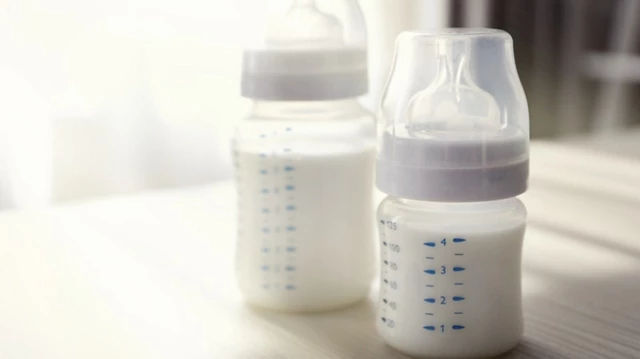It’s perfectly safe to switch to a new baby milk in one go. But if you’re moving on to (or away from) special milks – like Anti-Reflux or Comfort milk – it’s best to consult a healthcare professional first. Get practical advice on making the transition as smooth as possible when introducing a new baby milk.
Changing baby formula - How to switch to a new baby milk

Can I change my baby’s formula?
As your baby grows, their nutritional needs change. Follow On Milks (suitable from 6 months) and Toddler Milks (suitable from 1 year) are nutritionally tailored to support their development at different age stages. In this article, we will explain how you can change your baby’s formula milk.
How to Switch Baby Formula
If you’re thinking of moving on, it’s safe to simply make the switch to a new baby formula in one go. In fact, many parents choose to make a straight swap by replacing all feeds with a new formula.
However, you may prefer to move over to a new formula milk more slowly to allow your baby’s digestive system to adapt to the new compositional profile.
To introduce a new formula milk slowly, start with one feed of the new formula milk a day – ideally earlier in the day rather than later – while keeping all of the other feeds to your baby’s usual formula milk. Once this feed has become established (which can take two to three days), you can introduce a second feed of the new formula milk. Continue in this way until all of the feeds are with the new formula milk.
It can be quite a lengthy process, but it ensures that your baby has time to adjust, and that you feel confident and reassured they’re taking to it well.
To introduce a new milk slowly, start with one feed of the new milk a day – ideally earlier in the day rather than later – while keeping all of the other feeds to your baby’s usual milk.

Switching to an Anti-Reflux Formula
Suitable from birth, Anti-Reflux formula is a specially thickened formula designed to help feeds stay down.
- Before you make the switch to Anti-Reflux formula, first read about the symptoms of reflux. If you suspect your baby has reflux, it’s important to speak to your healthcare professional and get a medical diagnosis.
- If your healthcare professional advises you to switch over to Anti-Reflux formula straight away, it’s fine to do so by following the instructions on the side of the tub.
- If they advise you to change formula milks slowly, start with one feed of Anti-Reflux milk a day – ideally earlier in the day – while giving their usual milk at all other times.
- Once this new feed has become established (which can take two to three days) introduce a second feed of the new milk. Keep going until all of the feeds are with the Anti-Reflux formula milk.
Because Anti-Reflux formula is a thickened feed we recommend that you use a single-hole, fast flow teat. Also, never give any other antacids or feed thickeners alongside Anti-Reflux.
Switching to Hungry Infant milk
Hungry Infant Milk is a thicker formula which takes slightly longer to digest.
Because of its composition, it’s best to introduce Hungry Infant milk gradually to allow your baby’s digestive system to adapt. Start with one feed of Hungry Infant milk a day – ideally a morning feed – while giving their usual First infant milk at all other times. After two to three days introduce a second feed of the new milk, and continue until all feeds are with the new milk. Taking things slowly will give you the chance to make sure they have time to adapt to the new formula milk.
Switching to Comfort milk
Suitable from birth, Comfort Milk is formulated for the dietary management of colic and constipation. If you suspect that your baby is suffering from colic or constipation, it’s important to first consult your healthcare professional in order to receive a diagnosis. If your healthcare professional recommends Comfort Milk, they will also advise you to either switch milks straight away or make the move gradually.
To switch over to a new milk straight away, follow the instructions on the side of the new tub. To move over more gradually, introduce one feed of Comfort milk a day – preferably in the morning – but keep on giving their usual milk at all other times. After two to three days, introduce a second feed of the new milk, and keep going until all of the feeds are with Comfort Milk.
Moving on to Follow on Milks or Toddler Milks
If your baby no longer appears to experience the symptoms that require a special milk, it is important to speak to your healthcare professional if you're thinking of moving on to a regular formula milk depending on their age, such as Follow On milk after 6 months, or Toddler milk if they are approaching their first birthday.
It’s best to introduce a new formula milk gradually so that you can monitor your baby’s reaction and ensure they don’t experience any of their old symptoms. Taking it slow will give your baby's digestive system time to adapt to the differences between their old and new milks. Start by replacing their normal Comfort milk with a feed of the new milk. Then, after a couple of days, when you are happy they’re taking to it well, replace another feed. Carry on switching out a single feed every 2-3 days until all feeds are with the new milk.
What to do if you notice any changes
All our formula milks are designed and tested to ensure they meet strict quality and safety standards and are completely safe for your baby.
However, in the unlikely instance that you notice any signs of discomfort in your baby after switching to a new formula milk, contact your healthcare professional. It might simply be a case of trying again in a few weeks’ time.
Making up a formula milk feed
Any time you move onto a new formula milk, you’re advised to check the preparation instructions to ensure you’re up to date with the latest advice on how to prepare a feed.
Preparation instructions have changed over the years to keep in line with emerging health and safety regulations. But you’ll always find an up to date, step by step guide on our website, and on the back of each pack.
Practical next steps
- Speak to your healthcare professional if you’re moving on to, or from, Comfort, Anti-Reflux or Hungry Infant milk.
- Start slowly, with one morning feed of the new milk each day, then build up gradually.
- With any new milk, remind yourself of the preparation instructions on the back of each pack and follow them precisely.
- If you notice any changes or you have any concerns about the switch, contact your healthcare professional.
More from our experts

Need some help?
You can get quick answers to common questions in our FAQs.
Alternatively, if you need help with general pregnancy or baby advice, or maybe on using or ordering our products - our expert team are always on hand to talk about feeding your baby.
Important notice
Breastfeeding is best for babies and provides many benefits. It is important that, in preparation for and during breastfeeding, you eat a varied, balanced diet. Combined breast and bottle feeding in the first weeks of life may reduce the supply of your own breastmilk, and reversing the decision not to breastfeed is difficult. The social and financial implications of using an infant formula should be considered. Improper use of an infant formula or inappropriate foods or feeding methods may present a health hazard. If you use an infant formula, you should follow manufacturer’s instructions for use carefully – failure to follow the instructions may make your baby ill. Always consult your doctor, midwife or health visitor for advice about feeding your baby.


